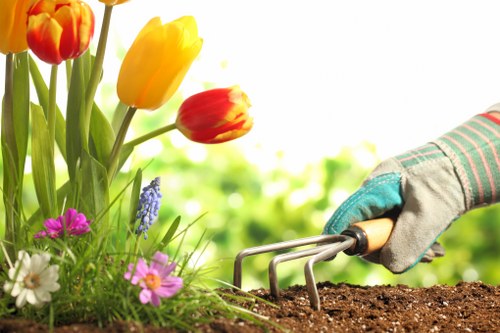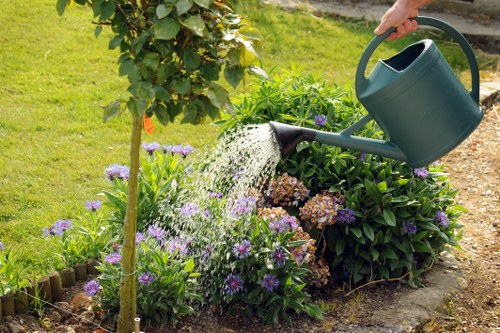Comprehensive Guide to Garden Maintenance in Greenwich

Introduction to Garden Maintenance
Maintaining a beautiful garden in Greenwich requires a combination of knowledge, effort, and the right resources. Whether you're a seasoned gardener or a beginner, understanding the essentials of garden maintenance can help your outdoor space thrive year-round.
In Greenwich, the climate poses unique challenges and opportunities for gardeners. With its temperate weather, homeowners have the chance to cultivate a diverse range of plants, from vibrant flowers to sturdy shrubs.
Proper garden maintenance not only enhances the aesthetic appeal of your property but also promotes a healthy ecosystem, attracting beneficial insects and wildlife.

Seasonal Garden Care
Spring Maintenance
Spring is a crucial time for revitalizing your garden after the winter months. Begin by clearing out debris and pruning dead branches to encourage new growth.
Planting fresh seeds and bulbs can add color and vitality to your garden. Ensure you choose plants that are well-suited to Greenwich's climate for optimal growth.
Regular watering and fertilization during spring set the foundation for a flourishing garden. Consider using organic fertilizers to enrich the soil naturally.

Summer Maintenance
Summer in Greenwich brings longer days and warmer temperatures, ideal for lush garden growth. It's essential to maintain consistent watering schedules to prevent plants from wilting.
Mulching around plants helps retain moisture and suppress weeds, reducing the need for frequent weeding.
Regularly inspect your plants for signs of pests or diseases. Early detection and treatment can save your garden from significant damage.

Autumn Maintenance
As the seasons change, autumn is the time to prepare your garden for the colder months. Start by harvesting remaining produce and removing spent plants.
Raking fallen leaves and composting them enriches the soil, providing nutrients for future plantings.
Protect sensitive plants by covering them or relocating potted plants indoors to shield them from frost.

Winter Maintenance
Winter requires less intensive maintenance but still demands attention. Clear snow and ice from plants to prevent breakage.
Prune trees and shrubs during their dormant period to promote healthy growth in the spring.
Plan your garden layout and select new plants for the upcoming seasons, ensuring a diverse and resilient garden.
Essential Tools for Garden Maintenance
Having the right tools is essential for efficient garden maintenance. Invest in quality equipment such as pruning shears, rakes, and watering systems to streamline your gardening tasks.
Consider eco-friendly tools that promote sustainability, reducing your garden's environmental footprint.
Pruning Tools
Pruning shears and loppers are vital for maintaining plant health and shaping shrubs and trees.
Watering Systems
Efficient watering systems, like drip irrigation, ensure your plants receive adequate moisture without wasting water.
Choosing the Right Plants for Greenwich
Selecting plants suitable for Greenwich's climate is crucial for a thriving garden. Opt for native species that are adapted to the local weather patterns and soil conditions.
- Perennials: Plants that return year after year, providing lasting beauty.
- Annuals: Seasonal flowers that offer vibrant colors throughout the growing season.
- Shrubs: Provide structure and serve as a natural barrier.
Incorporate a mix of flowering plants, foliage plants, and structural elements to create a balanced and visually appealing garden.
Pest and Disease Management
Effective pest and disease management is essential for maintaining a healthy garden. Regular monitoring and proactive measures can prevent infestations and outbreaks.
- Introduce beneficial insects like ladybugs to naturally control pests.
- Use organic pesticides to minimize harm to beneficial wildlife.
- Practice crop rotation to disrupt pest life cycles.
Maintaining proper plant spacing and ensuring adequate airflow reduces the risk of fungal diseases.
Soil Health and Fertilization
Healthy soil is the foundation of a thriving garden. Regularly test your soil to determine its pH and nutrient levels, allowing you to amend it accordingly.
Incorporate compost and organic matter to improve soil structure, drainage, and fertility.
Choose fertilizers that meet the specific needs of your plants, promoting robust growth and vibrant blooms.
Lawn Care in Greenwich
A well-maintained lawn enhances the overall appeal of your garden. Mow regularly, aerate the soil, and apply appropriate fertilizers to keep your grass healthy and lush.
- Mowing: Maintain a consistent mowing height to encourage strong root development.
- Aeration: Relieves soil compaction, allowing air and nutrients to reach the roots.
- Fertilization: Supports steady growth and resilience against pests and diseases.
Over-seeding bare patches ensures a dense and even lawn, reducing the likelihood of weed invasion.
Hardscaping and Garden Structures
Incorporating hardscaping elements like paths, patios, and garden structures adds functionality and aesthetic value to your garden.
Choose materials that complement your garden's style and withstand Greenwich's climate conditions.
Properly maintained hardscaping not only enhances beauty but also provides practical benefits, such as improved accessibility and organization.
Sustainable Garden Practices
Adopting sustainable practices ensures your garden remains healthy while minimizing environmental impact. Implementing water conservation techniques and choosing eco-friendly products contributes to a greener garden.
Consider rainwater harvesting systems to efficiently manage water usage, especially during dry spells.
Using recycled materials for garden structures and choosing native plants supports local biodiversity and reduces resource consumption.
Composting
Composting organic waste recycles nutrients back into the soil, promoting plant health and reducing landfill waste.
Mulching
Mulching conserves moisture, regulates soil temperature, and suppresses weed growth, leading to a more sustainable garden environment.
Professional Garden Maintenance Services
While DIY garden maintenance is rewarding, professional services offer expertise and efficiency, especially for larger or more complex gardens.
Hiring local Greenwich garden maintenance professionals ensures services are tailored to the specific needs of your area.
Services typically include regular mowing, pruning, pest control, soil management, and seasonal planting, providing comprehensive care for your garden.
- Customized Care Plans: Professionals create maintenance schedules based on your garden's unique requirements.
- Expert Advice: Gain insights into plant selection, garden design, and sustainable practices.
- Time Savings: Free up your schedule by entrusting garden tasks to experienced professionals.
Common Garden Maintenance Mistakes to Avoid
Even with the best intentions, certain mistakes can hinder your garden's growth. Being aware of these pitfalls can help you maintain a thriving outdoor space.
- Overwatering: Excessive watering can lead to root rot and attract pests.
- Under-fertilizing: Neglecting to provide essential nutrients can stunt plant growth.
- Improper Pruning: Incorrect pruning techniques can damage plants and impede their development.
Regular monitoring and education can prevent these common errors, ensuring your garden remains healthy and vibrant.
Enhancing Garden Aesthetics
Creating a visually appealing garden involves thoughtful design and attention to detail. Incorporate a variety of plant colors, textures, and heights to add depth and interest.
Use decorative elements like garden statues, lighting, and water features to enhance the overall ambiance and create focal points.
Maintaining symmetry and balance in your garden layout contributes to a harmonious and inviting outdoor space.
Color Coordination
Selecting complementary colors can create a unified and attractive garden palette.
Plant Arrangement
Strategically placing plants based on their height and blooming periods ensures continuous visual interest throughout the seasons.
Gardening Tips for Beginners
Starting a garden can be daunting, but with the right guidance, anyone can cultivate a thriving outdoor space. Here are some essential tips for novice gardeners in Greenwich.
- Start Small: Begin with a manageable garden size to build confidence and experience.
- Choose the Right Plants: Opt for plants that are well-suited to your local climate and soil conditions.
- Invest in Quality Tools: Reliable gardening tools make maintenance tasks easier and more efficient.
Patience and consistency are key. Regular care and attention will reward you with a beautiful and productive garden.
Conclusion
Effective garden maintenance in Greenwich involves a blend of seasonal care, proper tool usage, sustainable practices, and, when needed, professional assistance. By implementing these strategies, you can create and maintain a garden that not only enhances your property's beauty but also provides a thriving habitat for local flora and fauna.
If you're looking to elevate your garden's health and appearance, contact us today to discover how our expert services can help you achieve your gardening goals.

